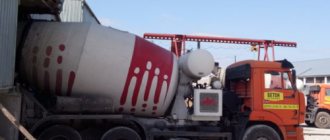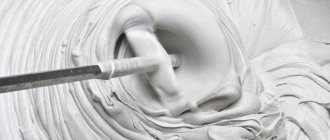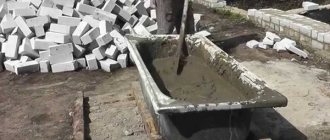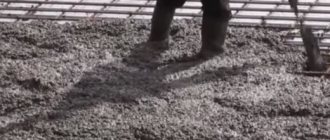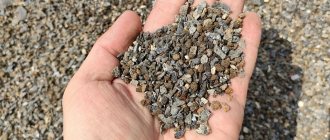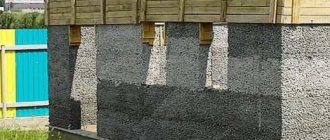Laitance is cement and water mixed in a certain ratio. The described solution is widely used in construction for strengthening concrete structures, sealing cracks, sealing screed seams, processing concrete pump hoses, metal containers, and expanded clay. When laitance is released on building concrete structures, it must be removed
How CM is used Source tggroup.co.uk
How to remove CM
To do this, you can use one of the methods for removing unwanted film:
Healthy! When chemically removing a film with a solution of hydrochloric acid, it is necessary to neutralize the composition using concentrated alkali. After applying the solution, the surface is thoroughly washed.
Despite all the disadvantages of CM, such compositions are quite often used for certain types of work.
Application of cement laitance in construction
- strength;
- good sound insulation;
- water resistance;
- thermal insulation properties;
- the mixture hardens quickly.
Cement laitance is a mixture consisting of water and cement, having the consistency of sour cream. To give it a lighter shade, a certain amount of slaked lime can be added to the solution.
Expanded clay is used for thermal insulation of ceilings and floors. This porous substance reduces the consumption of mortars. If the expanded clay layer is spilled with a mixture of cement and water, the granules stick together and the thermal insulation does not delaminate.
Before starting a concrete pumping line, the inside of the hoses is often treated with cement laitance. After treatment, they are not clogged with working mortars.
Properties of building materials
The characteristics of this simple mixture largely depend on the given proportions. Depending on the consistency, you can get a suspension, a slurry or a batter. The strength is affected by the brand of cement. When lime is added to the solution, an interesting texture and white color of the surface are obtained. The uniformity of the material is also important, otherwise the uniformity of the layer and its strength will not be achieved during application. The main properties include:
- waterproofness and smoothness of the frozen composition;
- good sound and heat insulation;
- ability to fill small cracks;
- rapid hardening;
- reliability;
- corrosion protection;
- ease of use.
How to prepare cement laitance? What is it used for?
Cement laitance dries and hardens quickly, serves as waterproofing, retains heat and does not allow sound to pass through. It is prepared for:
For suspension, ratio of components:
- Portland cement – 1 part;
- water – 2 parts.
In the liquid dough, the ratio is 1.5: 1, in the suspension - 1: 1.
The cement is sifted, freed from debris and lumps, and mixed with a construction mixer or drill with an attachment.
The technology for pouring expanded clay requires preparing milk in the form of a suspension. The composition is prepared as follows:
- sifted cement is dissolved in water to the consistency of sour cream;
- the composition is mixed with a mixer and the remaining water is gradually added to it;
- the solution is mixed until a homogeneous fluid mass is achieved.
To check the quality of the prepared mixture, it is recommended to perform the following steps:
- spill a small area;
- wait about 20 minutes;
- rate the quality.
To eliminate cracks and cracks, the solution is prepared slightly differently:
- take 2 parts of cement;
- 1 part water.
To make a cement screed, add the following to the milk:
When constructing a foundation, a sand cushion is placed underneath it. You can additionally spill the sand with a 1:1 suspension solution. If the milk is being prepared for finishing work indoors, you need to add 3 parts of sifted cement to 1 part water.
Floor screed with expanded clay.
A screed with expanded clay backing is installed in order to save cement and lighten the structure in the hope of obtaining a thick insulated layer. If done well, it is indeed possible to obtain such a layer, but this is far from the best option due to its labor intensity and the difficulty of producing a reliable bedding. In addition, floor screed with expanded clay can cause severe shrinkage, leading to cracks and dips, if the thickness of the covering layer of mortar is not large enough.
A layer of expanded clay of fraction 5/20 is poured onto the surface prepared for the screed. This can be either solid expanded clay or crushed clay, which is carefully laid on the surface and compacted. Since compacting expanded clay in an apartment to the degree of normal density in a solid is already a problem, we get the first disadvantage of screeds with bedding. The bedding layer is made so thick that the layer of cement-sand screed following it is at least 3 - 3.5 cm (and preferably 4 - 5 cm). 4 mm is placed on top. — reinforcing mesh with a cell of 100 x 100 mm. (you can take a larger mesh). Made.
Next, many specialists interfere with the central heating system and actively begin to pour the screed over the bedding, as a result of which the expanded clay simply floats to the top under the influence of gravity (in concrete screeds, the heavy fractions in the layer always sink down, the light fractions rise to the top). As a result, the master sands the floor with a grinder and then putsty on it. Basic work takes three times longer, and all because you need to prevent the expanded clay from floating. To prevent floating, the expanded clay is spilled with cement laitance. You need to pour it thoroughly until the layer of bedding is completely covered with milk and firmly stuck in place. The bedding is poured along with the already laid reinforcement, and cement laitance for expanded clay needs to be mixed only after the bedding has been made and the reinforcement has been laid (1 part M400 cement to 3 parts water). Then we lay the mortar (TsPS M300, if you mix it yourself, you can use M200), rub it in, dry it (not forgetting to take care of the screed) - and everything worked out.
Expanded clay concrete screed with a leveling layer.
The second type of screed is a screed made of expanded clay concrete with a leveling layer. Again, many craftsmen try to mix expanded clay concrete according to the proportions known to them, pour a layer, and then make sure that the expanded clay has risen to the surface, and the floor needs to be sanded and then topped up with a self-leveling mixture. The fact is that it is impossible to cast a slab with a smooth surface from expanded clay concrete under normal conditions: for this, this type of concrete is pumped into closed molds under pressure. However, there is a way in which you can safely lay expanded clay concrete without fear of the expanded clay floating, and get the same smooth surface as when laying a conventional DSP screed. To do this, however, you will need a lot more mixture.
The proportions for expanded clay concrete screed are as follows: for a 40-liter bucket we take 25 kg. A factory-made M300 TsPS bag, a 12-liter bucket of expanded clay of fraction 5/20 and about 5 liters of water (sometimes a little more water is needed, sometimes a little less - we work with 6-liter canisters marked 5 liters, adding as needed). In the example, the winter mixture Petrolit was used (but the filling was done in the summer).
Application of cement laitance in construction
- strength;
- good sound insulation;
- water resistance;
- thermal insulation properties;
- the mixture hardens quickly.
Kawabanga! Aerated concrete or brick
Cement laitance is a mixture consisting of water and cement, having the consistency of sour cream. To give it a lighter shade, a certain amount of slaked lime can be added to the solution.
Expanded clay is used for thermal insulation of ceilings and floors. This porous substance reduces the consumption of mortars. If the expanded clay layer is spilled with a mixture of cement and water, the granules stick together and the thermal insulation does not delaminate.
Before starting a concrete pumping line, the inside of the hoses is often treated with cement laitance. After treatment, they are not clogged with working mortars.
Pros and cons of floor insulation with expanded clay
I am often asked what properties expanded clay granules have more, positive or negative. The advantages include:
- Low thermal conductivity. The clays from which grains are made are themselves good heat insulators. The thermal insulation characteristics of the material are increased due to the pores that appear during its production.
- Relatively low cost.
- Fire safety. This material is fire resistant and does not emit toxic substances at high temperatures. This characteristic is especially important when insulating the floor in a wooden house.
- No harmful emissions into the environment. The use of expanded clay for insulating the floor of a wooden house does not reduce the environmental friendliness of the structure.
- Maintaining unchanged thermal insulation characteristics at high and low temperatures.
- Combination of good thermal insulation and sound insulation characteristics.
- Resistant to chemically aggressive substances and damage by rodents.
Low density. Due to its low specific gravity, the material does not place a large load on the floor.
The main disadvantage of expanded clay is its low resistance to moisture. The material strongly absorbs water and at the same time loses its thermal insulation qualities. Therefore, it is not recommended to use it in damp rooms without reliable moisture protection.
How to prepare cement laitance? What is it used for?
Cement laitance dries and hardens quickly, serves as waterproofing, retains heat and does not allow sound to pass through. It is prepared for:
For suspension, ratio of components:
- Portland cement – 1 part;
- water – 2 parts.
In the liquid dough, the ratio is 1.5: 1, in the suspension - 1: 1.
The cement is sifted, freed from debris and lumps, and mixed with a construction mixer or drill with an attachment.
The technology for pouring expanded clay requires preparing milk in the form of a suspension. The composition is prepared as follows:
- sifted cement is dissolved in water to the consistency of sour cream;
- the composition is mixed with a mixer and the remaining water is gradually added to it;
- the solution is mixed until a homogeneous fluid mass is achieved.
To check the quality of the prepared mixture, it is recommended to perform the following steps:
- spill a small area;
- wait about 20 minutes;
- rate the quality.
To eliminate cracks and cracks, the solution is prepared slightly differently:
- take 2 parts of cement;
- 1 part water.
To make a cement screed, add the following to the milk:
When constructing a foundation, a sand cushion is placed underneath it. You can additionally spill the sand with a 1:1 suspension solution. If the milk is being prepared for finishing work indoors, you need to add 3 parts of sifted cement to 1 part water.
Installation of beacons
The third stage is to install beacons. To do this, you need to determine the highest point of the sexual base. It is on it that the first lighthouse will be installed. Beacons are metal slats that are laid along and across the room, dividing it into sections. Expanded clay is poured right between them.
To install the beacons in a plane, wooden pads of varying thickness are placed under them. But there is an easier way. To do this, gypsum is diluted with water and the resulting mass in the form of slides is placed along the line of laying the lighthouse that is installed on them. Next, using a regular level, it is leveled horizontally, and gypsum mortar is placed under the low areas.
To level the beacons in one plane, a long two-meter level or rule is used. The distance between the profiles is set so that it is convenient for you to lay the rule on two adjacent slats or through one. For example, when the width of the room is 4 m, the distance between the profiles should not be more than 70 cm. Thus, the level will easily cover three beacons at the same time.
Laitance of cement - what is it, composition and proportions
What is it, scope of application and how to prepare it
Chemicals should be used carefully. If the technology is not followed, acid can damage concrete. After treatment, the surface is thoroughly washed with a stream of water.
But sometimes this liquid is needed for repairs. Laitance is used in the following cases:
- pouring expanded clay;
- ironing;
- imparting strength to plastered surfaces;
- repair of old concrete foundations;
- sealing cracks and potholes.
It is also selected for the waterproofing layer in metal containers. This helps protect them from corrosion due to water.
The composition can be prepared in three types and in the following ratios:
- suspension – 1:2;
- batter – 1.5:1;
- suspension – 1:1.
Positive qualities of milk from cement:
- water resistance;
- good thermal insulation;
- high speed of hardening.
Milk consumption per 1 m2 depends on the purpose of use. When pouring expanded clay, more composition will be required than when ironing. The cost per cube depends on the proportions of the components.
Popular tips
- Difficult erudition test: 10 We invite you to try your hand...
- Erudition test: master 10 Ten questions, and in each...
- Test: do you have a stable little thing that went wrong...
- An erudition test that they take. Show off your knowledge in the company?…
- A quick test of erudition from Try taking our test and...
- Knowledge test: show how Curiosity is a very good trait...
- An erudition test that is successful We invite you to test your knowledge...
- What should you not say in front of the mirror? A mirror as a frequently used item...
- A difficult test of erudition: only Ten questions, four answer options,…
- An interesting test: which hemisphere of the brain. There is a theory that the left and...
Why do you need to remove cement laitance?
First of all, you need to understand what cement laitance is.
Healthy! Sometimes CM is formed as a result of chemical reactions occurring in the concrete mass (under the influence of alkali metals). In addition, ash and other wastes are often added to concrete, which also lead to the formation of a milky film.
That is why during the concreting process it is important to remove cement laitance even before the screed has completely set.
Kawabanga! What brand of concrete is needed for the foundation of a house?
Laitance: scope of application
This mixture has the following advantages:
- water resistance;
- strength;
- high hardening speed.
The solution is also used before starting the concrete pumping line. It allows you to reduce the likelihood of hoses clogging when you start pumping mortar.
These cement-based solutions with the addition of water are not regulated by building codes. When choosing consistency and composition, builders are guided by their own experience and preferences.
Does laitance help against surface corrosion?
- What is cement laitance used for?
- Milk with cement - “harmful” factors
What is cement laitance used for?
As already mentioned, this material can be both “useful” and “harmful,” so for the sake of full disclosure, let’s consider both concepts. “Cement laitance” is a “useful” application in repair and construction practice:
It is worth noting that, since the proportions of “cement laitance” are not regulated by any regulatory documents, this issue is resolved in each specific case, “by eye,” based on the experience of a particular master builder.
Milk with cement - “harmful” factors
If the base of the “milk” is an aqueous solution of calcium hydroxide, a water-soluble film of calcium carbonate is formed on the surface of the base, which peels off, which leads to the gradual destruction of concrete.
Therefore, in these cases, “cement laitance” must be removed in the following ways:
The solution is applied to the concrete base, after which it is thoroughly washed with running water. This process reduces coating erosion and requires strict adherence to Safety Regulations and the use of personal protective equipment for workers.
Cement Lait Consumption Per 1 M2
Composition and proportions of cement milk
CEMENT "MILK". What is this?
Cement laitance
, What is this?
Explanation of what cement laitance
, how and why it is made. How to cook.
Preparation of expanded clay concrete
Preparing expanded clay concrete at home. Composition of expanded clay concrete. Filling the channels with expanded clay.
Application of cement laitance
Some amateur gardeners coat the inside of metal barrels with a liquid solution of cement and water, thereby preventing the formation of corrosion.
Before the first start-up of a concrete pump or construction pump line, laitance of cement is also used, which reduces the possibility of hose clogging during the initial stage of pumping the concrete mixture or mortar.
Like any mixture with a binder, cement
milk has a number of advantages, but these are strength, water resistance, sound insulation, thermal insulation, and rapid hardening.
A mortar based on cement and water alone is not regulated by GOST or other building codes. Therefore, the choice of composition and consistency should be guided by preference and type of use.
The process of stabilizing the expanded clay layer
The need to fill expanded clay with cement laitance is due to the properties of the material and the need to eliminate some negative factors.
- Improving the structural impermeability of the layer, strengthening it
- Guarantee of reliable filling of free spaces between granules
- Increasing the level of density and strength of expanded clay after the milk has dried
After the expanded clay has been poured with cement laitance, the layer becomes more stable, its integrity is not destroyed by the movement of people or light tools and mechanisms. You can perform screed pouring work faster and more efficiently, without the risk of granules floating up.
The milk is prepared in parts so that it can be used without any residue. The layer of expanded clay is shed gradually, as the mass is completely saturated with the solution. After a day, you can begin further work.
Cement laitance is a substance that can act both as a solution that destroys the screed and as a strengthening layer of expanded clay insulation, eliminating deformations and cracks. Depending on what and where the milk is used for, it is prepared according to different recipes (or quickly removed from the surface of the cement screed).
Source

